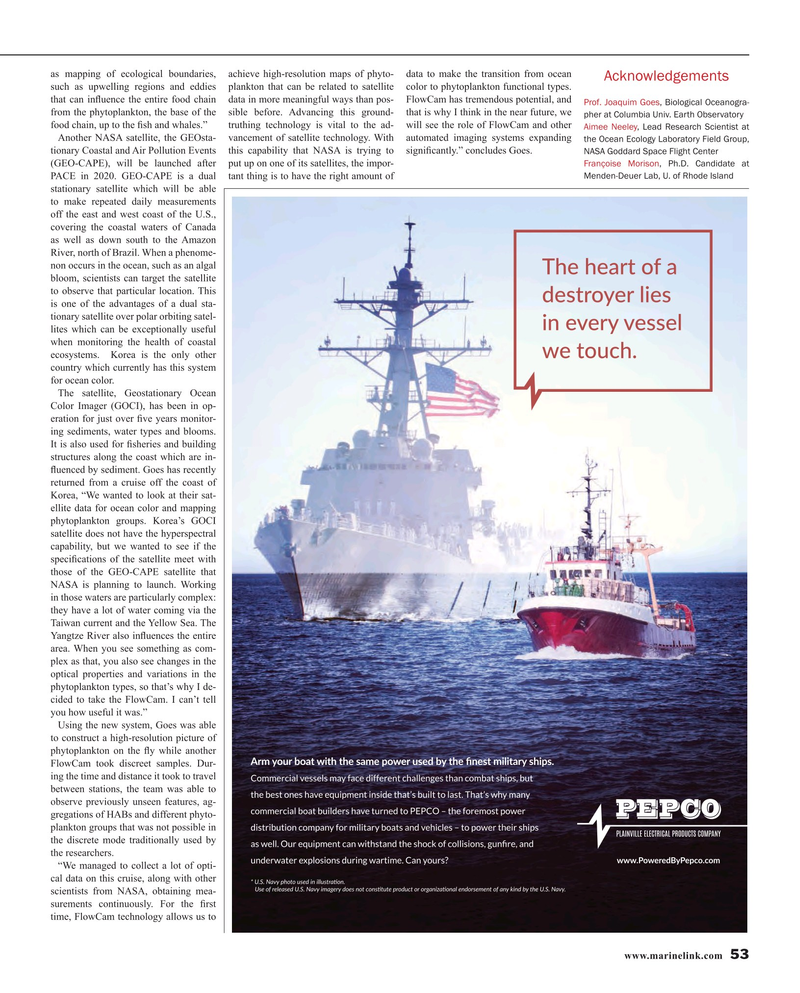
Page 53: of Maritime Reporter Magazine (November 2016)
Workboat Edition
Read this page in Pdf, Flash or Html5 edition of November 2016 Maritime Reporter Magazine
as mapping of ecological boundaries, achieve high-resolution maps of phyto- data to make the transition from ocean
Acknowledgements such as upwelling regions and eddies plankton that can be related to satellite color to phytoplankton functional types. that can in? uence the entire food chain data in more meaningful ways than pos- FlowCam has tremendous potential, and
Prof. Joaquim Goes, Biological Oceanogra- from the phytoplankton, the base of the sible before. Advancing this ground- that is why I think in the near future, we pher at Columbia Univ. Earth Observatory food chain, up to the ? sh and whales.” truthing technology is vital to the ad- will see the role of FlowCam and other
Aimee Neeley, Lead Research Scientist at
Another NASA satellite, the GEOsta- vancement of satellite technology. With automated imaging systems expanding the Ocean Ecology Laboratory Field Group, tionary Coastal and Air Pollution Events this capability that NASA is trying to signi? cantly.” concludes Goes.
NASA Goddard Space Flight Center (GEO-CAPE), will be launched after put up on one of its satellites, the impor-
Françoise Morison, Ph.D. Candidate at
Menden-Deuer Lab, U. of Rhode Island
PACE in 2020. GEO-CAPE is a dual tant thing is to have the right amount of stationary satellite which will be able to make repeated daily measurements off the east and west coast of the U.S., covering the coastal waters of Canada as well as down south to the Amazon
River, north of Brazil. When a phenome- non occurs in the ocean, such as an algal
The heart of a bloom, scientists can target the satellite to observe that particular location. This destroyer lies is one of the advantages of a dual sta- tionary satellite over polar orbiting satel- in every vessel lites which can be exceptionally useful when monitoring the health of coastal ecosystems. Korea is the only other we touch.
country which currently has this system for ocean color.
The satellite, Geostationary Ocean
Color Imager (GOCI), has been in op- eration for just over ? ve years monitor- ing sediments, water types and blooms.
It is also used for ? sheries and building structures along the coast which are in- ? uenced by sediment. Goes has recently returned from a cruise off the coast of
Korea, “We wanted to look at their sat- ellite data for ocean color and mapping phytoplankton groups. Korea’s GOCI satellite does not have the hyperspectral capability, but we wanted to see if the speci? cations of the satellite meet with those of the GEO-CAPE satellite that
NASA is planning to launch. Working in those waters are particularly complex: they have a lot of water coming via the
Taiwan current and the Yellow Sea. The
Yangtze River also in? uences the entire area. When you see something as com- plex as that, you also see changes in the optical properties and variations in the phytoplankton types, so that’s why I de- cided to take the FlowCam. I can’t tell you how useful it was.”
Using the new system, Goes was able to construct a high-resolution picture of phytoplankton on the ? y while another ul?o?u0o-|?b|_|_;v-l;ro?;u?v;70?|_;Cm;v|lb?b|-u?v_brvl
FlowCam took discreet samples. Dur- ing the time and distance it took to travel
Commercial vessels may face different challenges than combat ships, but between stations, the team was able to the best ones have equipment inside that’s built to last. That’s why many observe previously unseen features, ag- commercial boat builders have turned to PEPCO – the foremost power gregations of HABs and different phyto- plankton groups that was not possible in distribution company for military boats and vehicles – to power their ships
PLAINVILLE ELECTRICAL PRODUCTS COMPANY the discrete mode traditionally used by
EW[IPP3YVIUYMTQIRXGER[MXLWXERHXLIWLSGOSJGSPPMWMSRWKYRcVIERH the researchers. ???lo?;u;7?;r1ol1ol underwater explosions during wartime. Can yours? “We managed to collect a lot of opti- cal data on this cruise, along with other
R&?"?-??r_o|o?v;7bmb???v|u-?om? &v;o=u;?;-v;7&?"?-??bl-];u?7o;vmo|1omv?|?|;ruo7?1|ouou]-mb?-?om-?;m7ouv;l;m|o=-m?hbm70?|_;&?"?-???
scientists from NASA, obtaining mea- surements continuously. For the ? rst time, FlowCam technology allows us to www.marinelink.com 53
MR #11 (50-57).indd 53 11/4/2016 9:35:46 AM

 52
52

 54
54
